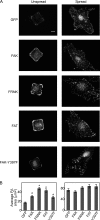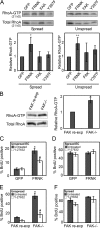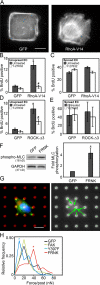An inhibitory role for FAK in regulating proliferation: a link between limited adhesion and RhoA-ROCK signaling
- PMID: 16847103
- PMCID: PMC2064187
- DOI: 10.1083/jcb.200510062
An inhibitory role for FAK in regulating proliferation: a link between limited adhesion and RhoA-ROCK signaling
Abstract
Focal adhesion kinase (FAK) transduces cell adhesion to the extracellular matrix into proliferative signals. We show that FAK overexpression induced proliferation in endothelial cells, which are normally growth arrested by limited adhesion. Interestingly, displacement of FAK from adhesions by using a FAK-/- cell line or by expressing the C-terminal fragment FRNK also caused an escape of adhesion-regulated growth arrest, suggesting dual positive and negative roles for FAK in growth regulation. Expressing kinase-dead FAK-Y397F in FAK-/- cells prevented uncontrolled growth, demonstrating the antiproliferative function of inactive FAK. Unlike FAK overexpression-induced growth, loss of growth control in FAK-/- or FRNK-expressing cells increased RhoA activity, cytoskeletal tension, and focal adhesion formation. ROCK inhibition rescued adhesion-dependent growth control in these cells, and expression of constitutively active RhoA or ROCK dysregulated growth. These findings demonstrate the ability of FAK to suppress and promote growth, and underscore the importance of multiple mechanisms, even from one molecule, to control cell proliferation.
Figures








Similar articles
-
Thrombospondin induces RhoA inactivation through FAK-dependent signaling to stimulate focal adhesion disassembly.J Biol Chem. 2004 Nov 19;279(47):48983-92. doi: 10.1074/jbc.M404881200. Epub 2004 Sep 13. J Biol Chem. 2004. PMID: 15371459
-
The G12/13-RhoA signaling pathway contributes to efficient lysophosphatidic acid-stimulated cell migration.Oncogene. 2006 Apr 6;25(15):2234-44. doi: 10.1038/sj.onc.1209261. Oncogene. 2006. PMID: 16301993
-
The effect of substrate microtopography on focal adhesion maturation and actin organization via the RhoA/ROCK pathway.Biomaterials. 2011 Dec;32(36):9568-75. doi: 10.1016/j.biomaterials.2011.08.077. Epub 2011 Sep 16. Biomaterials. 2011. PMID: 21925729
-
Focal adhesion kinase and endothelial cell apoptosis.Microvasc Res. 2012 Jan;83(1):56-63. doi: 10.1016/j.mvr.2011.05.003. Epub 2011 May 19. Microvasc Res. 2012. PMID: 21624380 Free PMC article. Review.
-
Focal adhesion kinase regulation of neovascularization.Microvasc Res. 2012 Jan;83(1):64-70. doi: 10.1016/j.mvr.2011.05.002. Epub 2011 May 14. Microvasc Res. 2012. PMID: 21616084 Free PMC article. Review.
Cited by
-
A novel strategy to increase the proliferative potential of adult human β-cells while maintaining their differentiated phenotype.PLoS One. 2013 Jun 12;8(6):e66131. doi: 10.1371/journal.pone.0066131. Print 2013. PLoS One. 2013. PMID: 23776620 Free PMC article.
-
Mammary gland ECM remodeling, stiffness, and mechanosignaling in normal development and tumor progression.Cold Spring Harb Perspect Biol. 2011 Jan 1;3(1):a003228. doi: 10.1101/cshperspect.a003228. Cold Spring Harb Perspect Biol. 2011. PMID: 20980442 Free PMC article. Review.
-
Mechanical Forces as Determinants of Disseminated Metastatic Cell Fate.Cells. 2020 Jan 19;9(1):250. doi: 10.3390/cells9010250. Cells. 2020. PMID: 31963820 Free PMC article. Review.
-
Hydroxyalkenals and oxidized phospholipids modulation of endothelial cytoskeleton, focal adhesion and adherens junction proteins in regulating endothelial barrier function.Microvasc Res. 2012 Jan;83(1):45-55. doi: 10.1016/j.mvr.2011.04.012. Epub 2011 May 6. Microvasc Res. 2012. PMID: 21570987 Free PMC article. Review.
-
Integrins and extracellular matrix in mechanotransduction.Cold Spring Harb Perspect Biol. 2010 Dec;2(12):a005066. doi: 10.1101/cshperspect.a005066. Epub 2010 Nov 17. Cold Spring Harb Perspect Biol. 2010. PMID: 21084386 Free PMC article. Review.
References
-
- Amano, M., M. Ito, K. Kimura, Y. Fukata, K. Chihara, T. Nakano, Y. Matsuura, and K. Kaibuchi. 1996. Phosphorylation and activation of myosin by Rho-associated kinase (Rho-kinase). J. Biol. Chem. 271:20246–20249. - PubMed
-
- Ayaki, M., K. Komatsu, M. Mukai, K. Murata, M. Kameyama, S. Ishiguro, J. Miyoshi, M. Tatsuta, and H. Nakamura. 2001. Reduced expression of focal adhesion kinase in liver metastases compared with matched primary human colorectal adenocarcinomas. Clin. Cancer Res. 7:3106–3112. - PubMed
-
- Balaban, N.Q., U.S. Schwarz, D. Riveline, P. Goichberg, G. Tzur, I. Sabanay, D. Mahalu, S. Safran, A. Bershadsky, L. Addadi, and B. Geiger. 2001. Force and focal adhesion assembly: a close relationship studied using elastic micropatterned substrates. Nat. Cell Biol. 3:466–472. - PubMed
Publication types
MeSH terms
Substances
Grants and funding
LinkOut - more resources
Full Text Sources
Molecular Biology Databases
Miscellaneous

